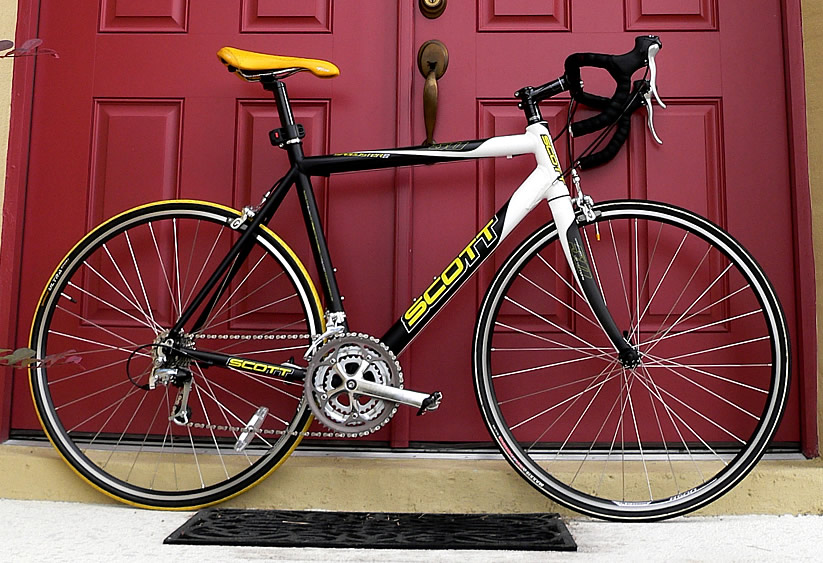|
Seatpost
A bicycle seatpost, seatpin, saddlepole, saddle pillar, or saddle pin is a tube that extends upwards from the bicycle frame to the saddle. The amount that it extends out of the frame can usually be adjusted, and there is usually a mark that indicates the minimum insertion (or maximum extension). Seatposts can be made of steel, aluminum, titanium, carbon fiber, or aluminum wrapped in carbon fiber. Attachment points Seatposts generally clamp directly onto saddle rails with which they must be compatible, while old or inexpensive seatposts slide into a separate clamp that then clamps the saddle rails. To attach it to the bicycle's main frame, the seatpost is inserted into the seat tube, which must be of a very slightly larger diameter (or a cylindrical shim can be used). The seatpost is held in place by squeezing the top of the seat tube with a tightening ring (temporarily reducing its diameter; a vertical slit cut into the tube allows this to happen without crumpling) until the ... [...More Info...] [...Related Items...] OR: [Wikipedia] [Google] [Baidu] |
Bicycle Saddle
A bicycle saddle, often called a bicycle seat, is one of five contact points on an upright bicycle, the others being the two pedals and the two handles on the handlebars. (A bicycle seat in the specific sense also supports the back.) The bicycle saddle has been known as such since the bicycle evolved from the draisine, a forerunner of the bicycle. It performs a similar role as a horse's saddle, not bearing all the weight of the rider as the other contact points also take some of the load. A bicycle saddle is commonly attached to the seatpost and the height of the saddle can usually be adjusted by the seatpost telescoping in and out of the seat tube. Components Typical saddles are composed of a few identifiable components. Shell The shell creates the shape of the saddle. The nose of the saddle is the forward most part. It is usually rounded. The shell can be made from several materials. Most modern saddles have a hard shell made from a moulded piece of plastic, such as ... [...More Info...] [...Related Items...] OR: [Wikipedia] [Google] [Baidu] |
Bicycle Frame
A bicycle frame is the main component of a bicycle, onto which wheels and other components are fitted. The modern and most common frame design for an upright bicycle is based on the safety bicycle, and consists of two triangles: a main triangle and a paired rear triangle. This is known as the ''diamond frame''. Frames are required to be strong, stiff and light, which they do by combining different materials and shapes. A frameset consists of the frame and fork of a bicycle and sometimes includes the headset and seat post. Frame builders will often produce the frame and fork together as a paired set. Variations Besides the ubiquitous diamond frame, many different frame types have been developed for the bicycle, several of which are still in common use today. Diamond In the diamond frame, the main "triangle" is not actually a triangle because it consists of four tubes: the head tube, top tube, down tube and seat tube. The rear triangle consists of the seat tube joined by ... [...More Info...] [...Related Items...] OR: [Wikipedia] [Google] [Baidu] |
Seat Tube
A bicycle frame is the main component of a bicycle, onto which wheels and other components are fitted. The modern and most common frame design for an upright bicycle is based on the safety bicycle, and consists of two triangles: a main triangle and a paired rear triangle. This is known as the ''diamond frame''. Frames are required to be strong, stiff and light, which they do by combining different materials and shapes. A frameset consists of the frame and fork of a bicycle and sometimes includes the headset and seat post. Frame builders will often produce the frame and fork together as a paired set. Variations Besides the ubiquitous diamond frame, many different frame types have been developed for the bicycle, several of which are still in common use today. Diamond In the diamond frame, the main "triangle" is not actually a triangle because it consists of four tubes: the head tube, top tube, down tube and seat tube. The rear triangle consists of the seat tube joined by p ... [...More Info...] [...Related Items...] OR: [Wikipedia] [Google] [Baidu] |
Graphite-reinforced Plastic
Carbon fiber-reinforced polymers (American English), carbon-fibre-reinforced polymers (Commonwealth English), carbon-fiber-reinforced plastics, carbon-fiber reinforced-thermoplastic (CFRP, CRP, CFRTP), also known as carbon fiber, carbon composite, or just carbon, are extremely strong and light fiber-reinforced plastics that contain carbon fibers. CFRPs can be expensive to produce, but are commonly used wherever high strength-to-weight ratio and stiffness (rigidity) are required, such as aerospace, superstructures of ships, automotive, civil engineering, sports equipment, and an increasing number of consumer and technical applications. The binding polymer is often a thermoset resin such as epoxy, but other thermoset or thermoplastic polymers, such as polyester, vinyl ester, or nylon, are sometimes used. The properties of the final CFRP product can be affected by the type of additives introduced to the binding matrix (resin). The most common additive is silica, but other a ... [...More Info...] [...Related Items...] OR: [Wikipedia] [Google] [Baidu] |
Trek Bicycle Company
Trek Bicycle Corporation is a bicycle and cycling product manufacturer and distributor under brand names Trek, Electra Bicycle Company, Bontrager, and Diamant Bikes. The company has previously manufactured bikes under the Gary Fisher, LeMond Racing Cycles, Klein, and Villiger Bikes brand names. With its headquarters in Waterloo, Wisconsin, Trek bicycles are marketed through 1,700 independently owned bicycle shops across North America, subsidiaries in Europe, Asia, South Africa, as well as distributors in 90 countries worldwide. Most Trek bicycles are manufactured outside the United States, in countries including the Netherlands, Germany, Taiwan, and China. History 1975–1979 — The early years In December, 1975, Dick Burke and Bevil Hogg established Trek Bicycle as a wholly owned subsidiary of Roth Corporation, a Milwaukee-based appliance distributor. In early 1976, with a payroll of five, Trek started manufacturing steel touring frames in Waterloo, Wisconsin, tak ... [...More Info...] [...Related Items...] OR: [Wikipedia] [Google] [Baidu] |
Racing Bicycle
A racing bicycle, also known as a road bike is a bicycle designed for competitive road cycling, a sport governed by and according to the rules of the Union Cycliste Internationale (UCI). Racing bicycles are designed for maximum performance while remaining legal under the UCI rules. They are designed to minimise aerodynamic drag, rolling resistance, and weight, and balance the desire for stiffness for pedaling effiency with the need for some flexibility for comfort. Racing bicycles sacrifice comfort for speed compared to non-racing bicycles. The drop handlebars are positioned lower than the saddle in order to put the rider in a more aerodynamic posture. The front and back wheels are close together so the bicycle has quick handling, which is preferred by experienced racing cyclists. The derailleur gear ratios are closely spaced so that the rider can pedal at their optimum cadence. However, racing bicycles must retain the ability to maneuver safely within a tightly-packed ... [...More Info...] [...Related Items...] OR: [Wikipedia] [Google] [Baidu] |
Matej Mohorič
Matej Mohorič (born 19 October 1994) is a Slovenian professional road racing cyclist who currently rides for UCI WorldTeam . Mohorič turned professional in 2014. He is the Slovenian road race champion for 2018 and 2021. Biography Born on 19 October 1994, in Kranj, Slovenia, Mohorič currently resides in Podblica, Slovenia. Mohorič won the 2012 UCI World Junior Road Race Championships and the 2013 UCI World Under-23 Road Race Championships, becoming the first rider to win world junior and under-23 titles in consecutive years. He signed with , a UCI ProTeam, for the 2014 season. Mohorič signed with , a UCI ProTeam, for the 2015 season. He was named in the start list for the 2015 Vuelta a España, but he withdrew on the 6th stage. Subsequently, it was announced that he would join from 2016 on a two-year contract. He was named in the start list for the 2016 Giro d'Italia. Mohorič secured his first Grand Tour stage win when he soloed to victory in Stage 7 of the 2017 V ... [...More Info...] [...Related Items...] OR: [Wikipedia] [Google] [Baidu] |
Mountain Bike
A mountain bike (MTB) or mountain bicycle is a bicycle designed for off-road cycling. Mountain bikes share some similarities with other bicycles, but incorporate features designed to enhance durability and performance in rough terrain, which makes them heavier, more complex and less efficient on smooth surfaces. These typically include a suspension fork, large knobby tires, more durable wheels, more powerful brakes, straight, extra wide handlebars to improve balance and comfort over rough terrain, and wide-ratio gearing optimised for topography and application (e.g., steep climbing or fast descending). Rear suspension is ubiquitous in heavier-duty bikes and now common even in lighter bikes. Dropper posts can be installed to allow the rider to quickly adjust the seat height (an elevated seat position is more effective for pedaling, but poses a hazard in aggressive maneuvers). Mountain bikes are generally specialized for use on mountain trails, single track, fire roads, and ... [...More Info...] [...Related Items...] OR: [Wikipedia] [Google] [Baidu] |
Aero Seatpost
Aero is a Greek prefix relating to flight and air. In British English, it is used as an adjective related to flight (e.g., as a shortened substitute for aeroplane). Aero, Ærø, or Aeros may refer to: Aeronautics Airlines and companies * Aero (Polish airline), a Polish airline founded in 1925 which later was merged into LOT * Aero Airlines, an Estonian airline owned by Finnair * Aero Commander, formerly known as Aero, a division of Rockwell International * Aero Cóndor, an airline based in Lima, Peru * Aero Contractors (Nigeria), a scheduled airline from Nigeria * Aero Contractors (United States), private charter company based in Smithfield, North Carolina * Aero O/Y, former name of Finnair * Aero Vodochody, a Czech aircraft manufacturer founded in 1919 * Aerocondor, Portuguese airline * Aeroflot, the flag carrier of the Russian Federation * Aerolíneas Argentinas, the flag carrier airline of Argentina * Aeroméxico, the flag carrier airline of Mexico * Aeroperú, a Peruvian air ... [...More Info...] [...Related Items...] OR: [Wikipedia] [Google] [Baidu] |
Bicycle Handlebar
A bicycle handlebar is the steering control for bicycles. It is the equivalent of a tiller for vehicles and vessels, as it is most often directly mechanically linked to a pivoting front wheel via a stem which in turn attaches it to the fork. Besides steering, handlebars also often support a portion of the rider's weight, depending on their riding position, and provide a convenient mounting place for brake levers, shift levers, cyclocomputers, bells, etc. History The dandy horse, or draisienne, invented by Karl Drais and the first vehicle with two wheels arranged in tandem, was controlled by a bar connected to the front steering mechanism and held by the riders' two hands. The first handlebars were solid bars of steel or wood, depending on the manufacturer. Curved, moustache-shaped, drop handlebars became popular in the 1920s. Whatton bars were developed in attempt to improve the safety of penny-farthings. Handlebars made of wood, instead of steel, were used on safety bicycle ... [...More Info...] [...Related Items...] OR: [Wikipedia] [Google] [Baidu] |





.jpg)
